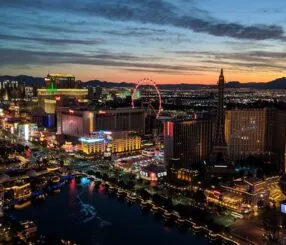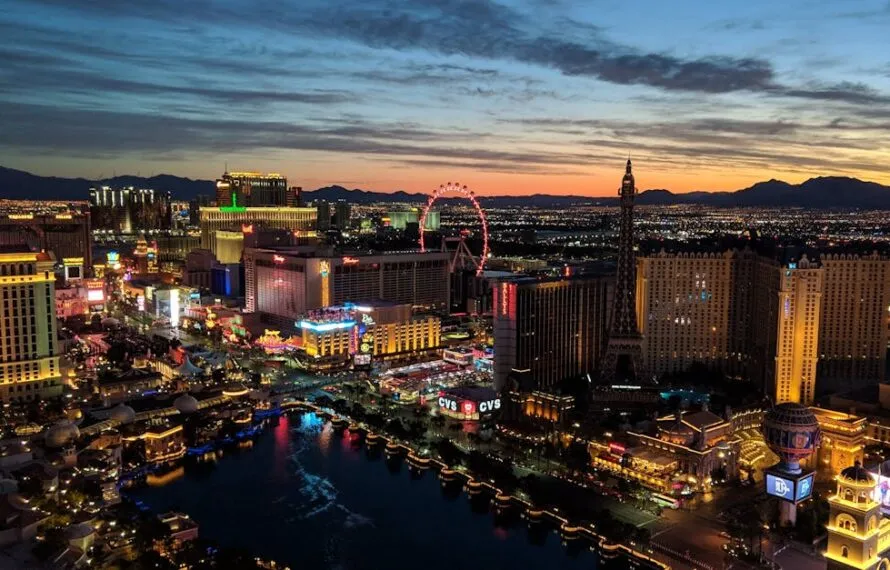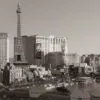As the sun sets over the neon skyline of Las Vegas, a haze often blankets the city, prompting many to wonder, “Where is the smoke in Las Vegas coming from?”
This question has become increasingly relevant as wildfires rage across the western United States, particularly in California and Nevada.
The smoke that drifts into the Las Vegas Valley can have profound implications for air quality and public health, making it essential to understand the sources and effects of this phenomenon.
In recent years, the frequency and intensity of wildfires have surged, driven by climate change and prolonged drought conditions.
As these fires burn, they release vast amounts of smoke into the atmosphere, which can travel hundreds of miles.
For residents of Las Vegas, this means that the smoke from distant fires can significantly impact their daily lives, from visibility issues to health concerns.
Understanding the primary sources of smoke in the area is crucial for residents and visitors alike.
O que este artigo aborda:
- Understanding the Primary Smoke Sources
- Wildfires in California and Nevada
- Local and Regional Prescribed Burns
- How Distant Fires Affect Las Vegas Air Quality
- Atmospheric Conditions and Wind Patterns
- The Role of Topography
- Current Air Quality and Health Implications
- Real-Time Air Quality Monitoring
- Potential Health Effects of Smoke Exposure
- Staying Informed and Protecting Yourself
- Official Alerts and Advisories
- Practical Tips for Personal Protection
- Looking Ahead to Future Smoke Events
- Anticipating Seasonal Wildfire Impacts
- Long-Term Climate Considerations
Understanding the Primary Smoke Sources
The smoke that often envelops Las Vegas primarily originates from wildfires in California and Nevada.
These fires can be sparked by a variety of factors, including lightning strikes, human activity, and extreme weather conditions.
In recent years, California has experienced some of the most devastating wildfires in its history, with flames consuming thousands of acres and sending plumes of smoke high into the atmosphere.
This smoke can travel across state lines, reaching Las Vegas and affecting its air quality.
In addition to wildfires, local and regional prescribed burns also contribute to the smoke seen in Las Vegas.
These controlled burns are conducted by fire management agencies to reduce fuel loads and mitigate the risk of larger, uncontrolled wildfires.
While they are a necessary part of forest management, the smoke produced can still drift into urban areas, creating temporary air quality issues.
Understanding the balance between wildfire prevention and air quality is essential for residents who may be affected by these practices.
Moreover, other minor atmospheric factors can play a role in the smoke that settles over Las Vegas.
Seasonal weather patterns, such as temperature inversions, can trap smoke close to the ground, exacerbating air quality issues.
Additionally, dust storms and other local environmental conditions can combine with smoke to create a thick haze, further complicating the air quality landscape in the region.
Wildfires in California and Nevada
The wildfires in California and Nevada are among the most significant contributors to the smoke that residents of Las Vegas experience.
In California, the combination of dry conditions, high winds, and an abundance of vegetation creates a perfect storm for wildfires.
The state has seen an increase in the number and severity of these fires, leading to widespread smoke that can travel across state lines.
The impact of these fires is not just localized; the smoke can affect air quality hundreds of miles away, including in Las Vegas.
In Nevada, wildfires also pose a threat, particularly in the northern and rural areas of the state.
These fires, while often less publicized than those in California, can still produce significant amounts of smoke that drift into the Las Vegas Valley.
The proximity of these fires means that residents may experience smoke from both local and distant sources, making it essential to stay informed about ongoing fire activity in the region.
Local and Regional Prescribed Burns
Prescribed burns are a critical tool in wildfire management, aimed at reducing the risk of larger, uncontrolled fires.
However, these burns can also contribute to the smoke that residents of Las Vegas encounter.
Fire management agencies conduct these burns during specific weather conditions to minimize the impact on air quality.
Nevertheless, the smoke produced can still affect nearby urban areas, particularly if winds shift unexpectedly.
For residents, understanding when and where prescribed burns are taking place can help mitigate concerns about air quality.
Local agencies often provide updates and advisories regarding these burns, allowing residents to prepare for potential smoke impacts.
While prescribed burns are necessary for long-term fire management, they highlight the delicate balance between maintaining safety and ensuring clean air.
How Distant Fires Affect Las Vegas Air Quality
The air quality in Las Vegas is influenced by various atmospheric conditions and wind patterns that can carry smoke from distant fires into the valley.
Understanding these dynamics is crucial for residents who may be affected by smoke exposure.
Wind patterns, particularly during certain times of the year, can transport smoke from wildfires in California and Nevada directly into the Las Vegas area, leading to spikes in particulate matter and other pollutants.
Additionally, the topography of the Las Vegas Valley plays a significant role in how smoke behaves.
The surrounding mountains can trap smoke, creating a stagnant layer of air that exacerbates air quality issues.
This phenomenon is particularly pronounced during temperature inversions, where warm air traps cooler air (and smoke) near the ground, leading to poor visibility and health concerns for residents.
Atmospheric Conditions and Wind Patterns
Atmospheric conditions, including wind patterns, are critical in determining how smoke from distant fires impacts Las Vegas.
During certain weather conditions, winds can carry smoke from wildfires hundreds of miles away, leading to noticeable air quality degradation.
For instance, during the summer months, prevailing winds often blow from the west, bringing smoke from California fires directly into the Las Vegas Valley.
Residents may notice changes in air quality and visibility during these events, prompting health advisories from local authorities.
Understanding these patterns can help residents prepare for potential smoke impacts, whether through staying indoors or using air filtration systems to improve indoor air quality.
Awareness of atmospheric conditions can empower residents to take proactive measures to protect their health.
The Role of Topography
The topography of the Las Vegas Valley significantly influences how smoke behaves in the region.
Surrounded by mountains, the valley can trap smoke, particularly during temperature inversions.
This phenomenon occurs when a layer of warm air sits above cooler air, preventing smoke from dispersing.
As a result, residents may experience prolonged periods of poor air quality during wildfire events.
Understanding the local topography can help residents anticipate when smoke may linger in the area.
For example, during certain weather patterns, the mountains may funnel smoke into the valley, leading to increased concentrations of pollutants.
By being aware of these dynamics, residents can make informed decisions about outdoor activities and health precautions.
Current Air Quality and Health Implications
As smoke from wildfires and prescribed burns permeates the air, the current air quality in Las Vegas becomes a pressing concern.
Real-time air quality monitoring systems provide valuable information about the levels of particulate matter and other pollutants in the air.
These systems allow residents to stay informed about air quality conditions and take necessary precautions to protect their health.
Potential health effects of smoke exposure can range from mild to severe, depending on individual sensitivities and the concentration of pollutants in the air.
For some, smoke can exacerbate respiratory conditions, leading to increased hospital visits and health complications.
Understanding the implications of smoke exposure is essential for residents, particularly those with pre-existing health conditions.
Real-Time Air Quality Monitoring
Real-time air quality monitoring is a vital tool for residents of Las Vegas, especially during wildfire season.
Local authorities and environmental agencies provide updates on air quality conditions, allowing residents to make informed decisions about outdoor activities.
These updates often include information on particulate matter levels, ozone concentrations, and health advisories.
Residents can access air quality data through various platforms, including mobile apps and websites.
Staying informed about current air quality conditions can help individuals take necessary precautions, such as limiting outdoor activities or using air purifiers indoors.
Awareness of air quality can empower residents to protect their health and well-being during smoke events.
Potential Health Effects of Smoke Exposure
The potential health effects of smoke exposure are a significant concern for residents of Las Vegas.
Smoke from wildfires contains a mixture of harmful pollutants, including particulate matter, carbon monoxide, and volatile organic compounds.
For individuals with respiratory conditions, such as asthma or chronic obstructive pulmonary disease (COPD), exposure to smoke can lead to increased symptoms and complications.
Even healthy individuals may experience adverse effects from prolonged smoke exposure, including respiratory irritation, coughing, and reduced lung function.
Understanding these risks is crucial for residents, particularly during periods of poor air quality.
Taking proactive measures, such as staying indoors and using air filtration systems, can help mitigate the health impacts of smoke exposure.
Staying Informed and Protecting Yourself
As smoke events become more frequent, staying informed and taking protective measures is essential for residents of Las Vegas.
Official alerts and advisories provide valuable information about air quality conditions and health recommendations.
Local health departments and environmental agencies often issue alerts during periods of poor air quality, advising residents on how to protect themselves.
Practical tips for personal protection include staying indoors during smoke events, using air purifiers, and wearing masks if necessary.
By taking these precautions, residents can minimize their exposure to harmful pollutants and protect their health.
Awareness of air quality conditions and proactive measures can empower individuals to navigate smoke events more effectively.
Official Alerts and Advisories
Official alerts and advisories are crucial for residents to stay informed about air quality conditions during smoke events.
Local health departments and environmental agencies provide timely updates on air quality levels, health recommendations, and safety precautions.
Residents can access this information through various channels, including websites, social media, and mobile apps.
By staying informed about official alerts, residents can make informed decisions about outdoor activities and take necessary precautions to protect their health.
Awareness of air quality conditions can empower individuals to respond effectively to smoke events, ensuring their safety and well-being.
Practical Tips for Personal Protection
Practical tips for personal protection during smoke events can significantly reduce exposure to harmful pollutants.
Staying indoors, particularly during periods of poor air quality, is one of the most effective ways to protect health.
Using air purifiers with HEPA filters can also help improve indoor air quality by removing particulate matter from the air.
For those who must go outside, wearing masks designed to filter out particulate matter can provide an additional layer of protection.
Additionally, keeping windows and doors closed can help prevent smoke from entering homes.
By implementing these practical measures, residents can safeguard their health during smoke events and navigate the challenges posed by poor air quality.
Looking Ahead to Future Smoke Events
As climate change continues to influence weather patterns and increase the frequency of wildfires, anticipating seasonal wildfire impacts becomes essential for residents of Las Vegas.
Understanding the potential for smoke events can help individuals prepare and respond effectively.
Seasonal forecasts and historical data can provide valuable insights into when to expect increased wildfire activity and associated smoke.
Long-term climate considerations also play a role in shaping the future of air quality in Las Vegas.
As temperatures rise and drought conditions persist, the likelihood of wildfires may increase, leading to more frequent smoke events.
Awareness of these trends can empower residents to take proactive measures to protect their health and well-being.
Anticipating Seasonal Wildfire Impacts
Anticipating seasonal wildfire impacts is crucial for residents of Las Vegas, particularly during the summer months when wildfire activity tends to peak.
Historical data and seasonal forecasts can provide insights into when to expect increased fire activity and potential smoke events.
By staying informed about these trends, residents can prepare for the possibility of poor air quality and take necessary precautions.
Local authorities often provide seasonal updates and advisories regarding wildfire risks, allowing residents to stay informed about potential smoke impacts.
Understanding the seasonal patterns of wildfire activity can empower individuals to respond effectively, ensuring their safety and health during smoke events.
Long-Term Climate Considerations
Long-term climate considerations are increasingly relevant as residents of Las Vegas navigate the challenges posed by smoke events.
Climate change is expected to influence weather patterns, leading to increased temperatures and prolonged drought conditions.
These factors can contribute to a higher frequency of wildfires, resulting in more frequent smoke events in the region.
By understanding the long-term implications of climate change, residents can take proactive measures to protect their health and well-being.
Awareness of these trends can empower individuals to advocate for policies that address climate change and promote sustainable practices in their communities.
As the landscape of air quality continues to evolve, staying informed and engaged will be essential for residents of Las Vegas.
In conclusion, the question of “Where is the smoke in Las Vegas coming from?” is a multifaceted issue influenced by wildfires, prescribed burns, and atmospheric conditions.
As residents navigate the challenges posed by smoke events, staying informed and taking proactive measures can significantly impact their health and well-being.
Understanding the sources of smoke, current air quality conditions, and practical protective measures will empower individuals to respond effectively to the challenges of smoke exposure in Las Vegas.





Sem comentários